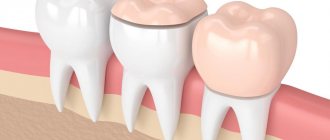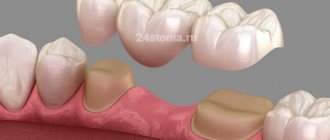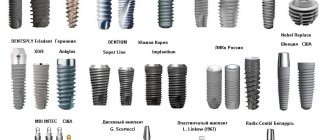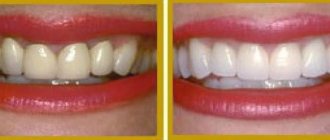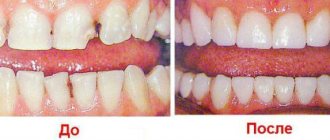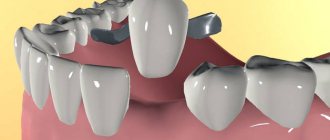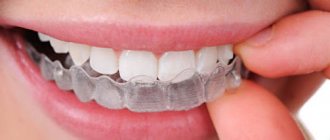When making dental prosthetics in dentistry, various materials and restoration technologies are used. One of the traditional materials, tested for decades, is gold. The qualities of elasticity, durability and strength are indicators that explain this choice.
It is this metal that can provide comfortable chewing of food for a long time and not deform. In addition, it is not an environment in which pathogenic microorganisms develop.
Features of gold crowns: what they are, how to install and remove them
Article navigation
- Use of gold in dentistry
- Features of pure gold prostheses
- Types of gold dental crowns
- Advantages and disadvantages of prostheses
- Indications for installation of crowns made of precious metals
- Who should not get gold prostheses?
- Features of making prostheses
- How does the installation work?
- Adjustment period: main problems
- How to remove a gold crown
- Who gets the crown after removal?
- Is it possible to clean the crown from glue residues?
- Features of product care
- How long can the product be used?
Question for a specialist
Until recently, a smile with a golden sheen was considered an indicator of the owner’s presentability and wealth. Gold crowns, due to the safety and softness of the material, were extremely popular, and the durability of the products is still demonstrated by representatives of the older generation. Meanwhile, modern materials used in dental prosthetics better meet aesthetic requirements. Why do many people prefer gold, what are the features of such products, how to clean gold crowns from residues - more on this and much more later in the article.
The first question is why?
Believing that these products are undemanding and durable in themselves, even if nothing is done to maintain their functionality, people make one of the most fatal mistakes. Without keeping an eye on them, after some time, they are surprised to discover that the structure has become unusable and needs urgent replacement. However, the cost of prosthetics cannot be called junk, so it is better to take care of the product in a timely manner in order to maximize its service life. But this is not the only reason; it makes sense to consider others:
Prevention of diseases, including infectious ones.
Preservation of supporting teeth (if any).
Eliminating bad breath.
Preservation of normal microflora in the oral cavity.
Neglecting the main postulates can lead to the development of various diseases. Therefore, it is very important to understand the questions of whether, with what and how to clean a plastic denture using folk remedies, how to store the product at home and what paste to use against dark plaque. After all, if the plastic itself does not suffer from non-compliance with standards, then it can quite realistically become a real breeding ground for pathogenic bacteria and other dangerous microorganisms.
Daily care
Structures can be made of various materials, for example, plastic and metal-plastic, nylon and acrylic, polyurethane and others, but they all equally need hygiene every day. There are several simple rules that must be followed so that they last a long time and do not cause health problems for the owner:
It's a good idea to start your morning by brushing your teeth. It makes sense to perform all the necessary manipulations, step by step.
Every time after eating, it is advisable to rinse the structure under running water to completely remove all, even the smallest particles of remaining food. You can brush your teeth, which serve as support teeth, with a regular brush, and your gums can be treated with special rinses.
Features of pure gold prostheses
Pure metal is not used to make gold “caps” - due to its high softness, it is not suitable for replacing natural teeth. As a rule, they use 900 and 750 gold, combining it with other elements (silver, copper, platinum), achieving the desired properties. By adding cadmium and brass, a 750 alloy is obtained, which is used as a solder to join individual parts of the prosthesis.
Only until 15.01 South Korean implant Osstem - from 18,500 rubles.
Hurry up to sign up for a free consultation and lock in promotional prices.
Call now or request a call
Opening hours: 24 hours a day - seven days a week
Apart from the aesthetic side of the issue, gold is an ideal material for dental reconstruction. It is not susceptible to rust, does not react with other metals, and does not cause allergies. Exceptional strength is combined with softness: the product tightly covers the patient’s own tissues, leaving no gaps for infection.
Another feature of gold crowns that allows their use in dentistry is the rate of compression and expansion of the precious metal, which is identical to that of one’s own dental tissues. This makes it possible to avoid the appearance of cracks and metal separation from the base during operation of the product.
Moreover, gold dentures are resistant to natural and artificial dyes, do not darken, and maintain a smooth structure for a long time.
What kind of gold is used in dentistry?
Dental crowns are made of gold of the highest standard not lower than 900. Low-grade alloys can also be used, but they are not of such quality. To give the tooth strength, copper and silver are added to the alloy. The production of dentures is carried out by a technician, and installation in the oral cavity is carried out by a dentist or prosthetist. Crowns are made in the form of caps-onlays. With their help, restoration of one or several teeth is carried out at once.
Installing gold dentures is rational if you need to strengthen or restore chewing teeth, improve the aesthetic appearance of the oral cavity, or if you have a strong bite.
Source
Types of gold dental crowns
There are two types of gold crowns for teeth:
- stamped - considered an outdated method of prosthetics made from industrial blanks (sleeves) or plates. They have a lot of disadvantages: lack of aesthetics, risk of gum injury, loose fit, the need to use a large amount of cement, in which gaps form over time,
- solid cast - a more modern method, which is based on the use of special equipment. They make it possible to exactly replicate the contour of a natural tooth, do not cause harm to soft tissues, and are characterized by a long service life. Among the disadvantages is the need to grind down a large amount of the tooth before installation.
In addition, gold products can be partially or completely covered with ceramics (metal-ceramic products), but they belong to a different type of prosthetics.
Kinds
Full
Complete – covers the tooth surface completely. Can be made using stamping from preliminary blanks. This method is rarely used. The one-piece manufacturing method is more often used. The monolith repeats the anatomy of its tooth. The technology is imperfect due to the need for preparation.
Half crown
Half-crown - a partial crown is a non-removable structure that covers the tooth on four surfaces: oral, lateral and incisal. The buccal or labial surface remains free. This type of crown is placed on premolars and front teeth. Another name is three-quarter, although in fact the product covers 4/5 of the tooth surface.
The structure can be used as a supporting element of a prosthesis (bridge, brugel) or as part of a splint.
Equatorial
Equatorial – covers the crown part of the tooth. This type is used when erasing enamel, as a support for splinting and as an element of bridge prostheses.
Stump
A stump crown is a deep structure for restoring a completely or partially destroyed tooth.
With metal-ceramic coating
Gold crown with metal-ceramic coating. The method is based on the production of a frame made of gold, which is covered with ceramic mass. This is done primarily for aesthetic purposes.
Pin
A crown on a pin is installed in case of complete loss of a tooth. The base, frame or entire prosthesis can be made of gold with or without a metal-ceramic coating.
Advantages and disadvantages of prostheses
Why do they put gold crowns on teeth? Products made from this metal have many advantages over other materials:
- have high antibacterial properties,
- do not cause allergies,
- do not lead to galvanic effect,
- have a long service life,
- characterized by increased strength,
- high plasticity rates make it possible to tightly fit the prosthesis on a unit of the dentition,
- do not have a negative effect on the enamel layer of neighboring teeth,
- do not cause irritation or increase sensitivity of soft gum tissues,
- the alloy does not contain any components harmful to health,
- do not oxidize,
- can be used for prosthetics of any unit of the dentition.
At the same time, one cannot fail to note some negative aspects of using gold crowns. For example, installing such products on the front teeth cannot be called aesthetic. In addition, the cost of gold prostheses is not affordable for all patients. They are often more expensive than even zirconium dioxide.
What type of denture can be used for the upper jaw?
Crowns
This non-removable type is used when the tooth is destroyed, but the root part is healthy (otherwise it is installed on an implant). The main tasks of the crown are to protect against further destruction and restore function. In modern dentistry, the following options are most often used:
- the most popular are metal-ceramic (metal frame with ceramic lining), metal-free or zirconium dioxide
. They have high strength and excellent aesthetics - indistinguishable from your own tooth; - cast metal crowns
are also sometimes used . They are quite durable, but visible in a smile and conversation; - stamped metal ones
are the cheapest, but short-lived and noticeable, and therefore are not used so often.
Life time
– from 3 years for stamped ones, up to 10-25 years or more for zirconium dioxide and metal-ceramic. Among the latter, frames made of titanium and an alloy of palladium and gold are particularly durable.
Dental bridge
Fixed technology to compensate for several adjacent lost teeth - from 1 to 4. Consists of two crowns, between which artificial units are located. The structure is installed on your own (supporting) teeth, and if they are missing or in poor condition, on implants. The most popular types of dental bridges are metal-ceramic, metal-free, and zirconium dioxide. They are strong enough to be used on painters and provide optimal pressure on the gums. Service life is from 10-15 years. Among the advantages of this technology:
- invisibility
– can be used even on the most visible areas of the upper jaw; - high level of restoration
of chewing functions; - comfort
for the patient - a minimum of contraindications, a short period of adaptation (from several hours to several days), after which the bridge completely ceases to be felt.
As for the disadvantages, it is the need to put crowns on healthy units. The option on implants does not have this disadvantage, however, the cost of prosthetics of the upper teeth in this way is higher and the same contraindications as for implantation become relevant.
Lamellar prosthesis
A removable design, which for many becomes the first association with the words “denture”. However, technology does not stand still, and inconvenient plastic options are becoming a thing of the past. nylon or acrylic are usually used
– they are hypoallergenic, lighter and more flexible. Such designs can be used:
- in the absence of teeth (completely edentulous) - in this case, the entire row is replaced, “sucking” to the palate. There are also special pastes for more reliable fixation;
- if you have your own units, partial dentures are used, fixed with special brackets (clasps). Clasps can be metal or plastic. The first ones are noticeable in a smile, the second ones are made to match the color of the gums and therefore are practically invisible.
In the case of the upper jaw, the inconvenience is that both full and partial constructions occupy a significant part of the palate in order to distribute the load during chewing. This can affect diction and taste. In addition, this technology has a fairly long period of adaptation – up to several months. However, the minimum contraindications and the most affordable price speak in its favor. Service life is about 5 years.
Indications for installation of crowns made of precious metals
A gold crown can be placed if the following indications exist:
- violation of the anatomical shape of the tooth,
- increased abrasion of the enamel layer,
- bruxism,
- if you are allergic to other, inexpensive alloys, in particular medical steel or nickel,
- the need for additional strengthening of the dental unit,
- tooth decay (usually the chewing group).
Some patients insist on using gold when undergoing dental prosthetics, so such a product can be installed at will.
How to clean white gold
Not all classical methods are suitable for cleaning jewelry made of white gold, which is an alloy of precious metal with copper, palladium or nickel - in particular, any vinegar is contraindicated.
White gold cleaning
White gold can be cleaned with soapy water, ammonia, liquid detergent, paste or baking soda solution
White gold with inlay cannot be boiled
: High temperature will weaken and even deform the places where the stones are attached. For glued stones, cleaning with immersion in aqueous solutions is not used. White gold with diamonds can be cleaned without contact with the stones: simply wipe them with a soft cloth - this is often enough to restore the shine. If the shine has not returned, use the standard toothpaste cleaning described above, then wipe the product dry.
Features of making prostheses
The process of making a gold crown depends on the type of product:
- stamped - based on X-ray data, a plaster blank is made in a dental laboratory, which is subsequently transferred to a gold sleeve. Using special tools and equipment, the specialist gives the precious metal product the desired shape and size, and then sends it to the clinic,
- solid cast - the orthopedic dentist takes impressions of both jaws, on the basis of which a wax model of the future product is made in the dental laboratory. Using a wax blank, the technician casts a gold crown and adjusts it to the specified parameters.
Throughout the entire manufacturing period, the patient is provided with a temporary structure.
Dishwashing liquid
Dish cleaning products contain active substances that remove even the most stubborn stains. They can be used to wash not only plates and pots, but also jewelry. Pour warm water about 38-40 °C into a container, add a few drops of liquid dishwashing detergent and stir. Do not use hot or boiling water, especially if your jewelry contains fragile gemstones: they may crack or change color when exposed to high temperatures. Soak gold items in the solution for about 20-30 minutes. Take them out and scrub them with a toothbrush with the softest bristles to remove dirt in hard-to-reach places. Rinse the gold with tap water and blot dry with a soft cloth.
Lemon
Lemon is famous for its cleansing properties. The citric acid contained in this citrus perfectly removes dirt from jewelry without damaging it. To restore its original appearance and characteristic shine, thoroughly rub the gold with a slice of lemon and then rinse with water. Wipe them with a paper towel and leave to dry. Finish by polishing with a soft cloth.
vote
Article rating
How does the installation work?
The installation of gold crowns can be generally described as follows:
- on a previously prepared tooth (ground to 0.5-1 mm, depulped), a prosthesis obtained from the laboratory is tried on, if necessary, it is adjusted,
- check the density of shrinkage and the correct closure of the teeth, while the patient should not feel discomfort,
- fix the product with dental cement.
You need to remember that you cannot get a gold crown in the first clinic you come across. To manufacture and install such products, a medical institution and laboratory must have a license. In addition, the specialist must have at least 5 years of work experience in this field.
How to clean gold plate
Of course, you cannot use any aggressive agents or abrasive cleaning in this case - there is a risk of damaging the thin layer of gold plating. It is better to clean a gold-plated chain, bracelet or ring in the following way:
- Prepare a solution: 1 liter of warm water, 1 tsp. soap shavings, 5-6 drops of ammonia.
- Soak the jewelry for half an hour - they should be completely immersed in the solution.
- Rinse in running water, dry on a napkin or towel.
- Polish with a suede cloth.
Adjustment period: main problems
Immediately after installation, you should not drink or eat for about 2 hours (the dentist will indicate a more precise time, since the duration of the period of abstinence depends on what type of cement was used for fixation). There are no special requirements regarding lifestyle changes.
In some cases, while getting used to the structure, the patient may encounter problems such as pain and discomfort, and increased tooth sensitivity. You must inform your dentist who performed the installation about any unusual or unpleasant sensations. It may be necessary to correct the position of the crown, or the situation is temporary, and the use of special products (rinse aid, paste) will be sufficient.
It will take some time to get used to, during which it is advisable to avoid eating solid foods so as not to accidentally damage your cheek or tongue.
Precautionary measures
Dental gold is not used for dental prosthetics in patients with mental disorders or chronic periodontitis. Contraindications to the installation of gold dentures are the period of pregnancy in women, as well as the patient’s age under 16 years. Naturally, gold prostheses made of gold are also not placed on mammary units. For the first few days after prosthetics, you should refrain from eating hard foods.
In some patients, the adaptation period is associated with certain discomfort - increased sensitivity of the “working” tooth, pain when biting. In a number of clinical cases, the fixing cement is washed out from under the prosthesis - this can lead to the development of local inflammatory processes and caries, and as a result, the crown may simply fall out. In this case, you should contact an orthopedic dentist - he will decide what can be done (remove the remaining cement, replace it with new material, insert the crown in place).
How to remove a gold crown
Removal of the structure is carried out strictly according to indications:
- expiration of service life,
- malocclusion,
- crown damage,
- carious lesion under the product,
- inflammation of the oral mucosa.
Gold caps can only be removed from teeth using a special device. For this purpose, forceps, ultrasonic and pneumatic equipment are used that destroy the material on which the product is fixed, and crown removers. As a rule, in a clinical setting, the question of how to separate a crown from a tooth does not arise, since the product is removed only after the cement has been destroyed. It is highly not recommended to carry out the procedure yourself - this can lead to damage to the soft and hard tissues of the gums and teeth.
Duration of use
With proper use and compliance with hygienic recommendations, the service life reaches 15-20 years. Significantly reduces the time of use of oral inflammation. The process can spread to the area where the free edge adjoins the gum and cause destruction of the cement.
It is prohibited to use dentures to open bottles or chew particularly hard food (nuts, bones). As a result, the alloy may chip and strength will be lost.
It is not recommended to chew hard food, otherwise the alloy may chip
The main part of the final price is the weight and purity of gold that went into production. The alloy can be purchased at a medical institution that provides services for the manufacture and implantation of prosthetic products. On average, 3 grams of metal are needed to correct one tooth; depending on the amount of work, the structure can weigh either more or less.
The remainder of the amount is the cost of the doctor’s services. The final price can be determined after inspection. As a rule, manufacturing and installation will require 10,000 rubles. After the end of their useful life, dentures can be removed by contacting a dentist and sold for melting down.
A large number of methods for restoring teeth confuses a person who is little familiar with this area. When choosing crowns made of gold, quality and ease of care for the structure are guaranteed, and the relatively high cost will more than pay for itself over years of use.
Who gets the crown after removal?
Patients often wonder whether the dentist should give away a gold crown. Yes, after removing the product, the doctor hands it over to the patient, because the gold alloy itself has already been paid for by the patient. The following question is often asked: how to remove teeth from gold crowns that were “inherited”? Here again, you should contact a dental technician in the laboratory if you want to keep the metal in good condition. Or try to gently tap with a hammer. But in any case, you will have to remove the remaining cement, so it is better to immediately contact a professional.
Is it possible to treat a tooth under a crown without removing it?
Dental treatment
under
the crown
is a serious problem.
The main difficulty lies in the need to treat the root canals again. This can only be done after removing the orthopedic structure, which will require re-installation of the crown
. In some cases, therapy is possible without removing the prosthesis.
Interesting materials:
Why do you need liquid for Polygel? Why do you need to wear pads? Why are atomic clocks needed? Why do you need iCloud copies? Why do we need crowns at Burger King? Why do you need credits in Battlefront 2? Why are magnets needed in a Rubik's cube? Why do we need discounts and promotions? Why do we need discounts on products? Why is a chemical bond formed?
Is it possible to clean the crown from glue residues?
When a gold crown is removed or falls out, cement residues remain on it. If the desire to install the precious prosthesis again does not arise, it can be sold for purchase. But before this, the product must be cleaned of the fixing material. To do this, use special products that dissolve dental cement, which can be purchased at a specialized store. But it is best to take the denture to a dental laboratory or contact the doctor who installed it. Of course, you will have to pay for this separately.
Precautionary measures
Dental gold is not used for dental prosthetics in patients with mental disorders or chronic periodontitis. Contraindications to the installation of gold dentures are the period of pregnancy in women, as well as the patient’s age under 16 years. Naturally, gold prostheses made of gold are also not placed on mammary units. For the first few days after prosthetics, you should refrain from eating hard foods.
In some patients, the adaptation period is associated with certain discomfort - increased sensitivity of the “working” tooth, pain when biting. In a number of clinical cases, the fixing cement is washed out from under the prosthesis - this can lead to the development of local inflammatory processes and caries, and as a result, the crown may simply fall out. In this case, you should contact an orthopedic dentist - he will decide what can be done (remove the remaining cement, replace it with new material, insert the crown in place).
How long can the product be used?
Gold crowns have a long service life - 15-20 years. Careful attitude and appropriate hygienic care can extend it to 25. But again, you need to look at the condition of both the supporting and opposing teeth. Nothing will happen to the crown itself during this time, but the rest, the living tissues, gradually fail. This explains the need to replace the prosthesis.
Despite the numerous advantages of using gold crowns in dental prosthetics, today dentistry still offers more advantageous options for crowns. For example, those made on the basis of zirconium dioxide or metal-ceramic on a gold basis. Such dentures will not only be strong and durable, but will also add naturalness and aesthetics to your smile.
Author: Sambuev B. S. (Thank you for your help in writing the article and the information provided)
Service life and proper care
How long a crown will last is influenced, for example, by proper preparation for the prosthetic procedure and compliance with all doctor’s recommendations for caring for them.
| Crown type | Service period |
| Ceramic | from 10 to 15 years |
| Metal-ceramic | from 7 to 14 years |
| Metal-ceramic based on precious metals | from 10 to 20 years |
| From zirconium dioxide | from 15 to 18 years old |
Basic rules of care
- It is necessary to brush your teeth 2 times a day using a slightly abrasive paste. Using auxiliary brushes and dental floss, it is necessary to completely clean the interdental spaces. An irrigator is required for home care. It is important to have a comprehensive oral cleaning done at your dental clinic periodically.
- When wearing metal-ceramic structures, it is recommended to give up bad habits (smoking). It is better to eat too cold, hot, hard, and sticky foods as little as possible. The recommendation applies more to those who use products made from fragile materials.
- Every six months you need to visit your dentist for a preventive examination. The doctor assesses the condition of the artificial tooth, which allows timely detection of the appearance of cracks or chips.
